Sie sind hier:
HOME »
Artikel »
Segment Analyse: SUV Innenraum Trends.
Segment Analyse: SUV Innenraum Trends.
Segment Analyse: SUV Innenraum Trends.
Zusammenfassung:
With a delay of about 15 years, the European car market is following the trend towards SUV vehicles in North America.
In the 5-years-period from 1999 to 2004, North American SUV production, in USA, Canada and Mexico (NAFTA free-trade zone), has increased from 5.6 to 6.2 million units (+11%), reflecting strong demand, essentially in the home markets (see graph below). The main players are Ford, Chevrolet, Jeep, GMC and Toyota.
In the same time period, European SUV production, in EU-25 and Turkey, has increased from 0.25 to 0.67 million units (+170%), and is expected to reach 1 million units in 2006 (see graph on page 2). The main players are Land Rover, BMW, Volkswagen, Honda and Volvo.
For this study, we have split the SUV segment in 3 classes: small, medium and large SUV. Fullsize trucks with a curb weight higher than 2.6 tons are not subject of this study.
The interior trends of SUV vehicles have evolved over time, and also within the three sub-classes:
From 1990 to 1994, a handful of large SUVs with upper-class interior have dominated the European market.
From 1995 to 1999, small and medium-size SUVs mushroomed. With basic to average interior equipment, they conquered a considerable market share, offering rugged driving behaviour and some off-road capabilities at low price.
From 2000 to 2004, the strong market demand persuaded virtually all European manufacturers to enter the SUV segment. The main approach was via the premium SUV class, thus avoiding competition with low-priced Asian vehicles and at the same time assuring high profit margins.
For the next 5-year-period, up to 2009, we predict a 2-digit yearly growth of the segment. The competition in the then over-crowded large premium SUV class and the need for replacement of the first wave of small and medium SUVs will shift the manufacturers attention to the medium SUV class. We expect a large number of new medium-size SUVs; newcomers will lure customers with innovative interior features and high electronic content, to compete against already established models and their replacement products.
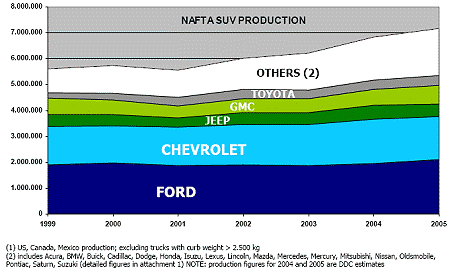
1. The European SUV boom:
The 2002 EU production kick-off was initiated by Honda, Porsche, Volvo and VW. Land Rovers new 2002 Range Rover was the start of a renewal of its model line-up. In 2004, BMWs X3 followed, and established the trend of premium mid-size SUV.
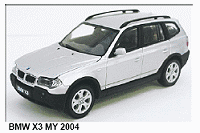
European SUV production, in EU-25 and Turkey, has currently reached a 2-digit growth rate per year, and is expected to reach 1 million units in 2006 (see graph on page 4). Even after 2006, an end of this exceptional growth is not in sight. The main players are Land Rover, BMW, Volkswagen, Honda and Volvo. However, both French manufacturers, PSA and Renault, will add SUVs to their model line-up latest 2006. 2. SUV segment definitions
The recent SUV boom on the European market (see graph below) has led to hard competition within the SUV segment.
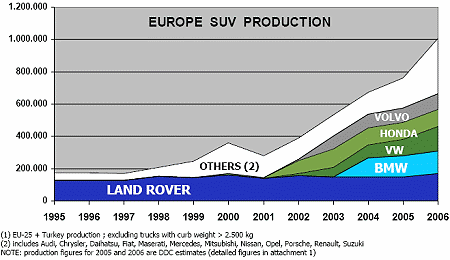
For a better understanding of the dynamics inside the segment, we have divided it in three sub-classes (SUV-A to SUV-C), by using the ratio of curb weight and car length to distinguish between the classes.
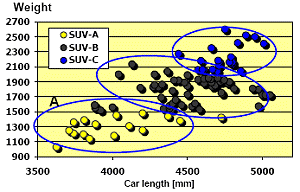
SUV-A
1,10-1,60 tons 3,70-4,60m -> hard plastic
SUV-B
1,60-2,10 tons 4,10-5,00m -> soft trim
SUV-C
2,00-2,60 tons 4,50-5,00m -> cast/leather
Since OR vehicles present the same interior characteristics as MV-C, in this study, they have been integrated in category SUV-C.
3. Non-European manufacturers dominance
Land Rover, Mercedes G and Lada Niva have long been the only European partisans in this field. Since 2000, European OEMs no longer let this important vehicle niche to Japanese or Korean car-makers ; out of the 38 new SUVs that have been announced for the five years to come, 20 will be produced in European assembly plants:
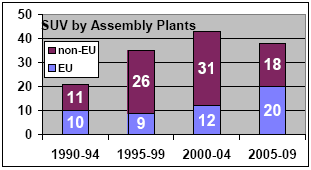
Similar picture for the brands involved: a majority of the 38 identified future models comes from European brands:
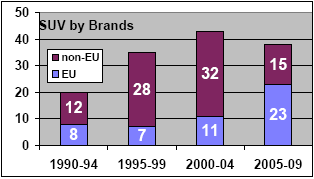
4. Segment evolution since 1990
In this report, 98 small, medium and large SUVs that are commercialized on the European market are analysed. The segment evolution in the periods 1990 to 1994, 1995 to 1999 and 2000 to 2004 is described. All models are identified in three tables, with their main characteristics.
a) 1990 to 1994 (22 models) We have included Daihatsu Rocky, Lada Niva and Mercedes G-class that started earlier. With the exception of 5 models, all cars in this segment came from Japanese OEM. Land Rover and Mercedes� G and M class were the only models from European OEMs, while Ford Explorer was the only US model.
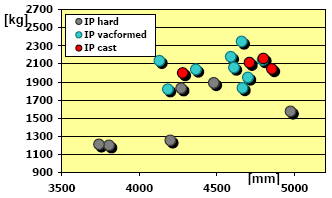
Interior was mostly soft surface.
(Table for models identification .. attachment).
b) 1995 to 1999 (35 models)
In the 5 years period starting 1995, the number of new all-road models had almost doubled to reach 35, mainly in the light and medium SUV classes. Six of these models were available in 3-door and 5-door versions.
Still dominance by Japanese OEM. Daihatsu, Honda, Mitsubishi, Nissan and Suzuki had started assembly in European facilities.
Interior:
80% basic features, with hard surfaces, poor acoustic damping, minimum safety features (popularisation of the segment).
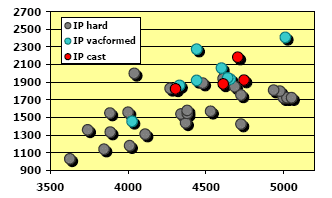
(Table for models identification .. attachment).
c) 2000 to 2004 (38 models)
Since 2000, marked increase in the large SUV class, with luxury interior. In fact, the interior of these vehicles is indistinguishable from the interior of an executive or luxury sedan. BMW, Porsche, Volvo and VW have responded to the increasing SUV demand.
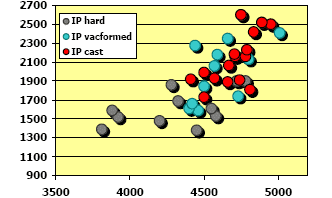
5. SUV interior trends
For evaluation of SUV interiors, we have focussed on the recent models, with start of production between 2001 and end of 2004. The following criteria were used (perceived quality):
.. hard trim is present in over 60% of all models in this study ;
.. soft trim (vacuum-formed or cast surfaces with foam backing) is found in 40% of all models, notably in the medium and luxury SUV classes.
.. door panel carriers are made of water-proof materials (injected plastic or steel sheet) ; no natural fibre carriers used.
.. fit & finish is quite basic in off-roaders (gap width and gap tolerances, colour match, gloss), while it is very important in SUVs.
.. IP assembly (separate binnacles, centre consoles, etc.)
.. acoustic insonorisation is a big issue in medium and large SUVs; most of the rugged off-roaders (often with soft-tops!) are poorly insonorised.
a) SUV-A interior trends
b) SUV-B interior trends
This sub-class shows the greatest variety of possible styles, indicating a strong dynamic for differentiation inside the SUV-B range.
General trends are:
Molded bottle-holder
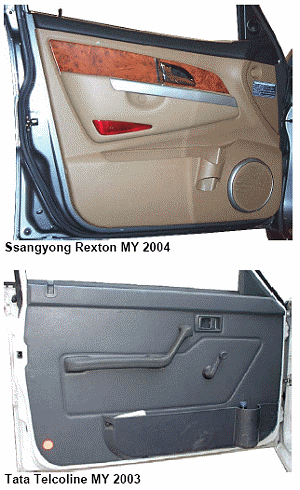
Soft bottle-holder
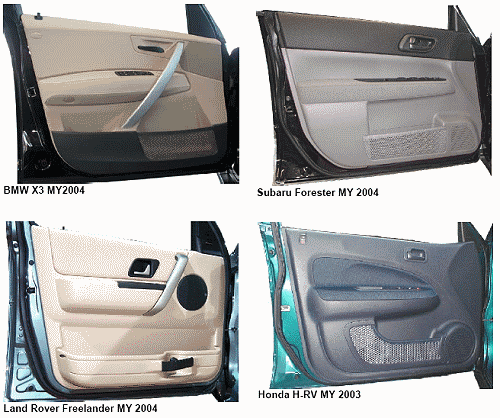
Separate bottle pocket
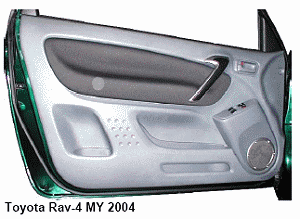
6. The battle in the luxury-SUV field
SUV-C vehicles have to combine rugged offroad capabilities with luxury sedan-like interior. Virtually all European premium car manufacturer are currently entering this field, with guaranteed market growth and high profitability being the drivers.
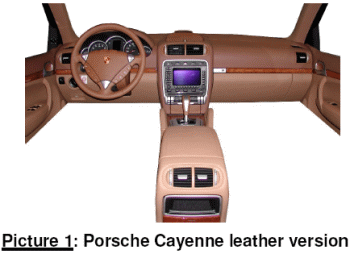
Innovative features of MY 2004/2005 SUVs more in detail:
a) door-panel storages
Former map pockets in doors panels are more and more destinated to hold bottles with content from 0.5 to 1.0 Liter, even in off-road environment.
b) centre console storages
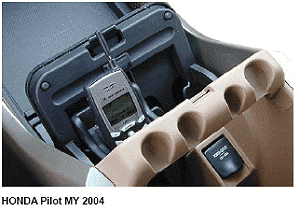
Mobile phone unit located before centre armrest instead of screwed on IP
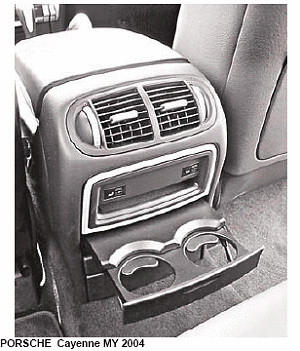
Cup-holder for rear passengers.
c) IP storages
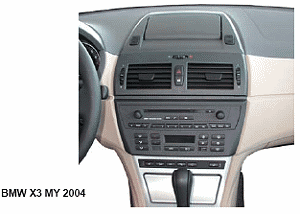
Useful feature, copied from minivan design.
d) additional handles
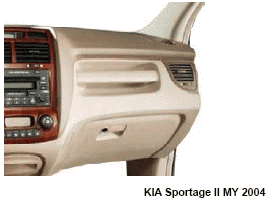
Additional handles, located on IP passenger side, on A pillars or integrated in centre consoles are a feature reminding military vehicles, but nevertheless quite useful in offroad environment.
e) infotainment
CD-ROM based navigation systems (DVDbased system optional, however not recommended because they are quite sensitive to vehicle vibrations in off-road environment)
MMI (man-machine interface)
Central command button, with menu on flatscreen located in centre console; development for head-up display (HUD) has started.
7. Future Trends
a) new SUV announcements
The table below identifies 40 new SUVs coming to (European) market between 2005 and 2009.
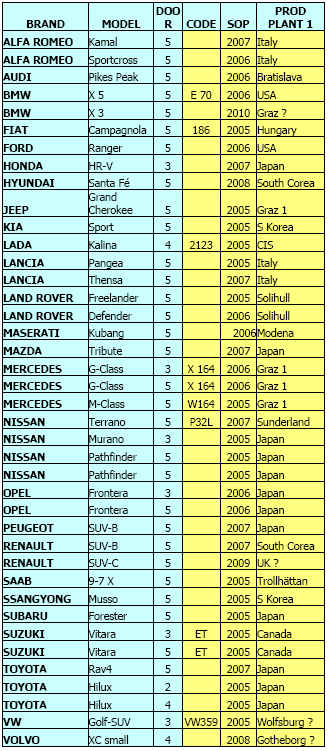
Start-of-Production years given in this table were announced in February 2005 and are subject to change.
Some non-European projects may be assembled in future European plants (for European sales volume, or vehicles designed for the European market).
For the next 5-year-period, we predict a 2-digit yearly growth of the segment, up to 2009. The competition in the then over-crowded large premium SUV class and the need for replacement of the first wave of small and medium SUVs will shift the efforts to the medium SUV class. We expect a large number of new medium-size SUVs; new-comers will attract customers with innovative interior features and high electronic content, to compete against already established models and their replacement products.
b) SUV-B replacements to come
In the next years, most SUV-B models, with SOP between 1997 and 2000, are to be replaced. We expect a large number of new medium-size SUVs from both European and non-European brands; new-comers to this segment, like French PSA Group (Citroen, Peugeot brand) or Renault currently transfer know-how from Japanese partners to speed-up market introduction. The interior of these vehicles, however, will be 100% European style.
No SUV model plans are currently known from Dacia, Jaguar, Seat and Skoda. Fiat is working hard on AWD for all of his models, however these car-based models are to be considered as cross-overs. The Fiat Campagnola, announced for MY2005, is of SUV type.
The crucial question for all manufacturers is how to upgrade the interior features and at the same time keep manufacturing cost low.
c) new interior features
Three trends are visible for next SUV generation:
d) interior design trends
The design trends will be dominated by:
e) additional trends
In the following table, we have summarized some additional trends we predict for next SUV generation:
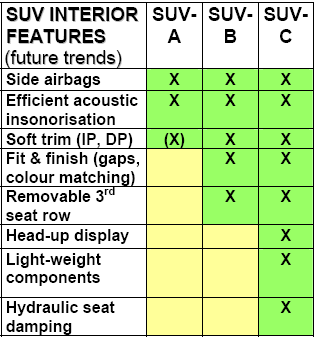
Zusammenfassung:
With a delay of about 15 years, the European car market is following the trend towards SUV vehicles in North America.
In the 5-years-period from 1999 to 2004, North American SUV production, in USA, Canada and Mexico (NAFTA free-trade zone), has increased from 5.6 to 6.2 million units (+11%), reflecting strong demand, essentially in the home markets (see graph below). The main players are Ford, Chevrolet, Jeep, GMC and Toyota.
In the same time period, European SUV production, in EU-25 and Turkey, has increased from 0.25 to 0.67 million units (+170%), and is expected to reach 1 million units in 2006 (see graph on page 2). The main players are Land Rover, BMW, Volkswagen, Honda and Volvo.
For this study, we have split the SUV segment in 3 classes: small, medium and large SUV. Fullsize trucks with a curb weight higher than 2.6 tons are not subject of this study.
The interior trends of SUV vehicles have evolved over time, and also within the three sub-classes:
From 1990 to 1994, a handful of large SUVs with upper-class interior have dominated the European market.
From 1995 to 1999, small and medium-size SUVs mushroomed. With basic to average interior equipment, they conquered a considerable market share, offering rugged driving behaviour and some off-road capabilities at low price.
From 2000 to 2004, the strong market demand persuaded virtually all European manufacturers to enter the SUV segment. The main approach was via the premium SUV class, thus avoiding competition with low-priced Asian vehicles and at the same time assuring high profit margins.
For the next 5-year-period, up to 2009, we predict a 2-digit yearly growth of the segment. The competition in the then over-crowded large premium SUV class and the need for replacement of the first wave of small and medium SUVs will shift the manufacturers attention to the medium SUV class. We expect a large number of new medium-size SUVs; newcomers will lure customers with innovative interior features and high electronic content, to compete against already established models and their replacement products.

1. The European SUV boom:
The 2002 EU production kick-off was initiated by Honda, Porsche, Volvo and VW. Land Rovers new 2002 Range Rover was the start of a renewal of its model line-up. In 2004, BMWs X3 followed, and established the trend of premium mid-size SUV.

European SUV production, in EU-25 and Turkey, has currently reached a 2-digit growth rate per year, and is expected to reach 1 million units in 2006 (see graph on page 4). Even after 2006, an end of this exceptional growth is not in sight. The main players are Land Rover, BMW, Volkswagen, Honda and Volvo. However, both French manufacturers, PSA and Renault, will add SUVs to their model line-up latest 2006. 2. SUV segment definitions
The recent SUV boom on the European market (see graph below) has led to hard competition within the SUV segment.

For a better understanding of the dynamics inside the segment, we have divided it in three sub-classes (SUV-A to SUV-C), by using the ratio of curb weight and car length to distinguish between the classes.

SUV-A
1,10-1,60 tons 3,70-4,60m -> hard plastic
SUV-B
1,60-2,10 tons 4,10-5,00m -> soft trim
SUV-C
2,00-2,60 tons 4,50-5,00m -> cast/leather
Since OR vehicles present the same interior characteristics as MV-C, in this study, they have been integrated in category SUV-C.
3. Non-European manufacturers dominance
Land Rover, Mercedes G and Lada Niva have long been the only European partisans in this field. Since 2000, European OEMs no longer let this important vehicle niche to Japanese or Korean car-makers ; out of the 38 new SUVs that have been announced for the five years to come, 20 will be produced in European assembly plants:

Similar picture for the brands involved: a majority of the 38 identified future models comes from European brands:

4. Segment evolution since 1990
In this report, 98 small, medium and large SUVs that are commercialized on the European market are analysed. The segment evolution in the periods 1990 to 1994, 1995 to 1999 and 2000 to 2004 is described. All models are identified in three tables, with their main characteristics.
a) 1990 to 1994 (22 models) We have included Daihatsu Rocky, Lada Niva and Mercedes G-class that started earlier. With the exception of 5 models, all cars in this segment came from Japanese OEM. Land Rover and Mercedes� G and M class were the only models from European OEMs, while Ford Explorer was the only US model.

Interior was mostly soft surface.
(Table for models identification .. attachment).
b) 1995 to 1999 (35 models)
In the 5 years period starting 1995, the number of new all-road models had almost doubled to reach 35, mainly in the light and medium SUV classes. Six of these models were available in 3-door and 5-door versions.
Still dominance by Japanese OEM. Daihatsu, Honda, Mitsubishi, Nissan and Suzuki had started assembly in European facilities.
Interior:
80% basic features, with hard surfaces, poor acoustic damping, minimum safety features (popularisation of the segment).

(Table for models identification .. attachment).
c) 2000 to 2004 (38 models)
Since 2000, marked increase in the large SUV class, with luxury interior. In fact, the interior of these vehicles is indistinguishable from the interior of an executive or luxury sedan. BMW, Porsche, Volvo and VW have responded to the increasing SUV demand.

5. SUV interior trends
For evaluation of SUV interiors, we have focussed on the recent models, with start of production between 2001 and end of 2004. The following criteria were used (perceived quality):
- hard/soft trim
- fit & finish (radii, colour & gloss match, gaps)
- acoustic insonorisation
.. hard trim is present in over 60% of all models in this study ;
.. soft trim (vacuum-formed or cast surfaces with foam backing) is found in 40% of all models, notably in the medium and luxury SUV classes.
.. door panel carriers are made of water-proof materials (injected plastic or steel sheet) ; no natural fibre carriers used.
.. fit & finish is quite basic in off-roaders (gap width and gap tolerances, colour match, gloss), while it is very important in SUVs.
.. IP assembly (separate binnacles, centre consoles, etc.)
.. acoustic insonorisation is a big issue in medium and large SUVs; most of the rugged off-roaders (often with soft-tops!) are poorly insonorised.
a) SUV-A interior trends
- low-cost materials (injected polypropylene)
- no decoration trim
- poor fit & finish (gaps, colour match)
- no adjustable steering column
- no centre arm-rest
b) SUV-B interior trends
This sub-class shows the greatest variety of possible styles, indicating a strong dynamic for differentiation inside the SUV-B range.
General trends are:
- soft or hard surfaces (no clear trend today)
- limited use of decoration trim (premium brands)
- poor fit & finish (gaps, colour match)
- adjustable steering column
- centre arm-rest (standard or optional)
Molded bottle-holder

Soft bottle-holder

Separate bottle pocket

6. The battle in the luxury-SUV field
SUV-C vehicles have to combine rugged offroad capabilities with luxury sedan-like interior. Virtually all European premium car manufacturer are currently entering this field, with guaranteed market growth and high profitability being the drivers.

Innovative features of MY 2004/2005 SUVs more in detail:
a) door-panel storages
Former map pockets in doors panels are more and more destinated to hold bottles with content from 0.5 to 1.0 Liter, even in off-road environment.
b) centre console storages

Mobile phone unit located before centre armrest instead of screwed on IP

Cup-holder for rear passengers.
c) IP storages

Useful feature, copied from minivan design.
d) additional handles

Additional handles, located on IP passenger side, on A pillars or integrated in centre consoles are a feature reminding military vehicles, but nevertheless quite useful in offroad environment.
e) infotainment
CD-ROM based navigation systems (DVDbased system optional, however not recommended because they are quite sensitive to vehicle vibrations in off-road environment)
MMI (man-machine interface)
Central command button, with menu on flatscreen located in centre console; development for head-up display (HUD) has started.
7. Future Trends
a) new SUV announcements
The table below identifies 40 new SUVs coming to (European) market between 2005 and 2009.

Start-of-Production years given in this table were announced in February 2005 and are subject to change.
Some non-European projects may be assembled in future European plants (for European sales volume, or vehicles designed for the European market).
For the next 5-year-period, we predict a 2-digit yearly growth of the segment, up to 2009. The competition in the then over-crowded large premium SUV class and the need for replacement of the first wave of small and medium SUVs will shift the efforts to the medium SUV class. We expect a large number of new medium-size SUVs; new-comers will attract customers with innovative interior features and high electronic content, to compete against already established models and their replacement products.
b) SUV-B replacements to come
In the next years, most SUV-B models, with SOP between 1997 and 2000, are to be replaced. We expect a large number of new medium-size SUVs from both European and non-European brands; new-comers to this segment, like French PSA Group (Citroen, Peugeot brand) or Renault currently transfer know-how from Japanese partners to speed-up market introduction. The interior of these vehicles, however, will be 100% European style.
No SUV model plans are currently known from Dacia, Jaguar, Seat and Skoda. Fiat is working hard on AWD for all of his models, however these car-based models are to be considered as cross-overs. The Fiat Campagnola, announced for MY2005, is of SUV type.
The crucial question for all manufacturers is how to upgrade the interior features and at the same time keep manufacturing cost low.
c) new interior features
Three trends are visible for next SUV generation:
- Since the style of minivans and SUVs are approaching to each-other (cross-overs), interior features from both segments will be found in future SUVs.
- The rush to the medium-size SUV sub-class (SUV-B) will lead to a downward shift of interior features from large, premium SUVs towards SUV-Bs.
- The growing political pressure for vehicles that are less polluting will lead to a wider use of light-weight materials and components in the most exposed sub-class, that is large SUV (SUV-C). The car interior will have to contribute to this weight-reduction target. The extraordinary growth potential of the medium-sized SUV sub-class will lead to a technological avalanche, stimulated mainly by European and Asian manufacturers.
d) interior design trends
The design trends will be dominated by:
- Authenticity (leather, metal, wood)
- Family-orientation (storages, easy-to-clean)
- Versatility (flexible seating and trunk)
- For overall appreciation: Environmentally friendly (diesel, gas engines)
e) additional trends
In the following table, we have summarized some additional trends we predict for next SUV generation:
